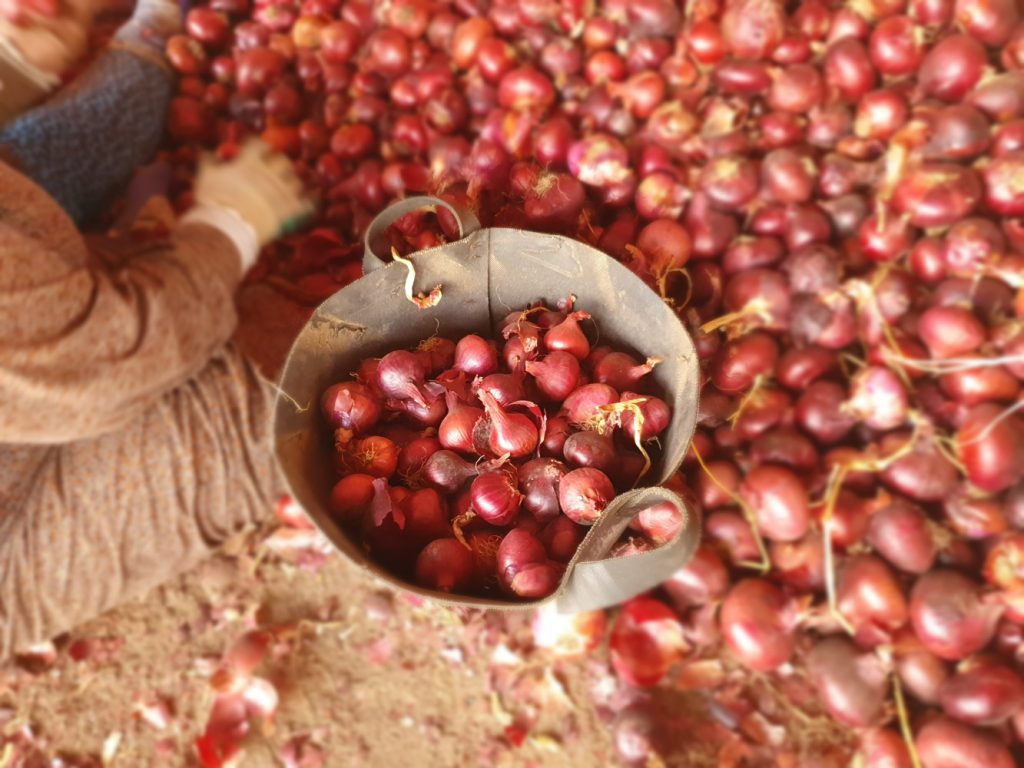Unpacking India’s Garlic and Onion Price Surge: What’s Changed Over the Last Three Years?
Mostafa Adel
Indian consumers are facing an unprecedented surge in the prices of garlic and onions, two essential kitchen staples, due to a combination of adverse weather conditions and supply chain disruptions. Over the past three years, these challenges have only intensified, pushing prices to new highs in 2024. Here’s a detailed look at the current situation and how it compares with previous years, based on insights from market experts.
A Closer Look at the 2024 Price Surge
This year, garlic prices in India have reached unprecedented levels. Wholesale prices have surged to ₹350-₹400 per kg (approximately $4.20-$4.80 per kg), while retail prices have skyrocketed to ₹400-₹500 per kg (about $4.80-$6.00 per kg). Within just one week, prices jumped by nearly ₹60 per kg (around $0.72 per kg). A similar scenario unfolded in February 2024 when delayed sowing and harvesting cycles pushed prices up to ₹400-₹500 per kg ($4.80-$6.00 per kg) in the markets.
According to Deepak J Shah, Secretary of the Bengaluru Wholesale Garlic Traders’ Association, the primary reason for this year’s price surge has been the harsh summer conditions, particularly in March. “Most of the garlic supply comes from Madhya Pradesh, Rajasthan, Gujarat, and Uttar Pradesh. The summer in March was especially harsh, and crops from Uttar Pradesh and Gujarat were spoiled. As a result, the entire country is now relying on garlic from Rajasthan and Madhya Pradesh, leading to a shortfall of supply,” Shah explained. This dependency has caused a significant supply crunch, driving up prices.
Similarly, onion prices have also increased by ₹10-₹15 per kg (about $0.12-$0.18 per kg) in wholesale markets due to a shortage of supply. B. Ravi Shankar, Secretary of the Onion Merchants’ Association of Bengaluru, attributed the hike to crop losses in Karnataka and strategic stockpiling by Maharashtra suppliers. Shankar noted that onion prices could decrease next week, provided there are no heavy rains that damage crops further.

Comparative Analysis: Price Trends from 2021 to 2024
To better understand the current situation, let’s compare it with the trends over the past three years:
1. 2021: Relatively Stable with Minor Fluctuations
– In 2021, garlic prices were relatively stable, ranging from ₹200-₹250 per kg (around $2.40-$3.00 per kg), and onions were priced between ₹30-₹40 per kg (about $0.36-$0.48 per kg). While transportation disruptions during the COVID-19 pandemic caused occasional price fluctuations, the supply chain remained largely intact, with no significant weather disruptions affecting crop quality or yield.
2. 2022: The First Signs of Trouble
– By 2022, erratic monsoon patterns began affecting key onion-producing states like Maharashtra and Karnataka, causing moderate price increases. Garlic prices also started to rise due to sporadic weather issues, with prices ranging from ₹250-₹300 per kg (approximately $3.00-$3.60 per kg). Onion prices saw a minor increase of ₹5-₹10 per kg (about $0.06-$0.12 per kg).
3. 2023: Climate Impact and Rising Input Costs
– The situation worsened in 2023 as input costs for seeds, fertilizers, and transportation surged. Additionally, unseasonal rains and heatwaves severely affected the garlic and onion crops. Garlic prices climbed to ₹300-₹350 per kg (about $3.60-$4.20 per kg), while onion prices ranged from ₹40-₹50 per kg (around $0.48-$0.60 per kg). In response, farmers began stockpiling, further reducing market supply and driving prices higher.
4. 2024: Severe Weather Conditions and Record Prices
– This year has been particularly challenging, with garlic prices reaching ₹400-₹500 per kg (approximately $4.80-$6.00 per kg) — the highest in four years. Onion prices have increased by ₹10-₹15 per kg (about $0.12-$0.18 per kg) in wholesale markets, driven by crop damage and strategic stockpiling in Maharashtra. The combination of a harsh summer and unseasonal rains has led to these unprecedented price levels.

What’s Behind the Price Surge?
Several key factors are contributing to this ongoing crisis:
– Climate Change and Unpredictable Weather Patterns: Unusual weather conditions, such as harsh summers and unexpected rains, have directly impacted crop quality and yield, particularly in major producing states.
– Supply Chain Disruptions: Crop spoilage and strategic stockpiling by farmers have led to significant supply shortages, exacerbating price increases.
– Changes in Consumer Behavior: Faced with rising prices, consumers are purchasing smaller quantities and waiting for prices to stabilize before buying in bulk.
Looking Ahead: What to Expect in the Coming Months
The outlook remains uncertain, with much hinging on upcoming weather patterns. If heavy rains continue, further crop damage could sustain high prices or even cause them to rise further. However, if the weather stabilizes, there could be some relief for consumers and a potential reduction in prices.

Conclusion
The ongoing shortage of garlic and onions in India highlights the vulnerabilities in the agricultural supply chain, driven by climate challenges and supply disruptions. Addressing these challenges requires coordinated efforts across stakeholders — from better weather prediction models to improved storage facilities and strategic government interventions to stabilize markets.
Best Regards
Mostafa Adel
Last updated November 10, 2024